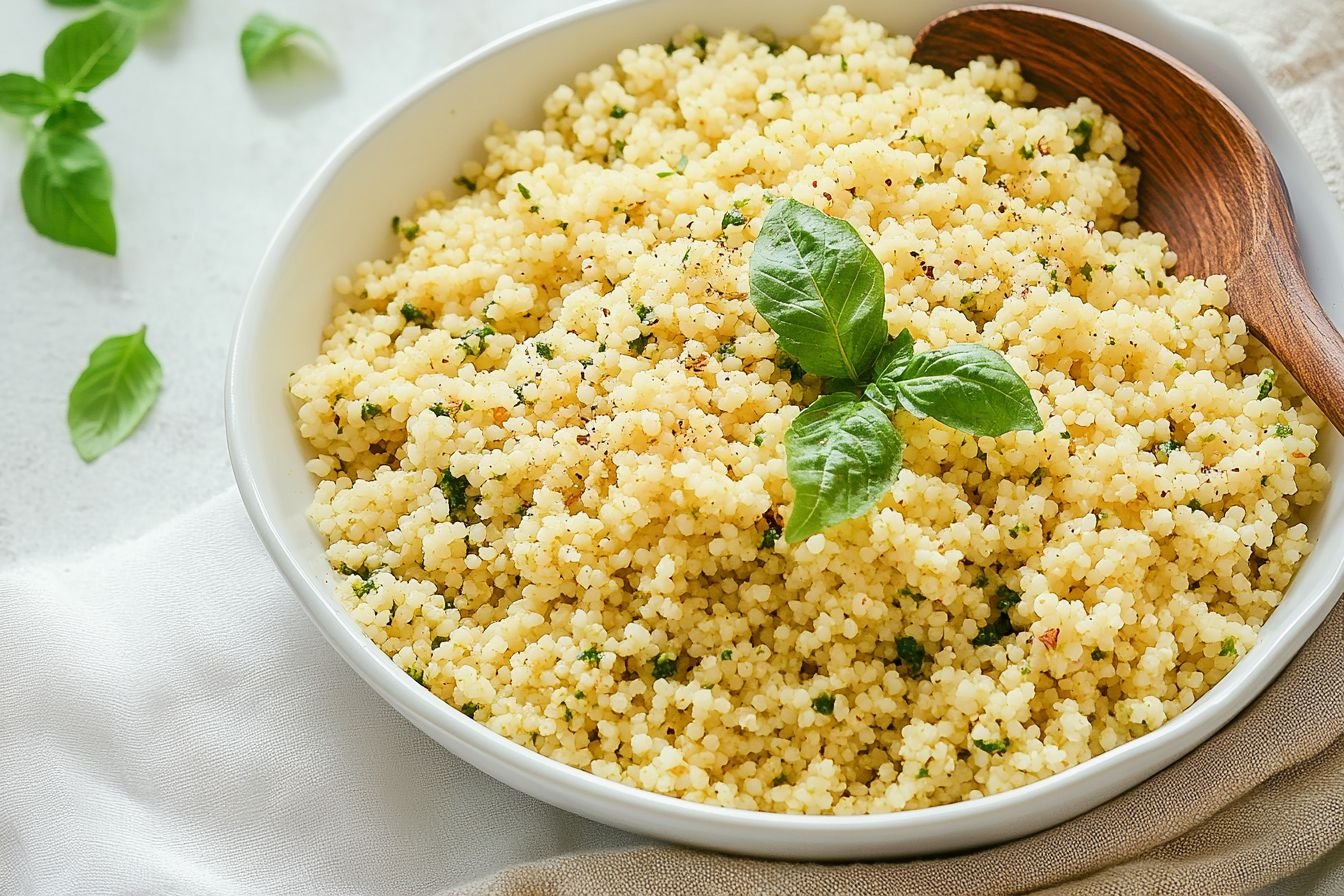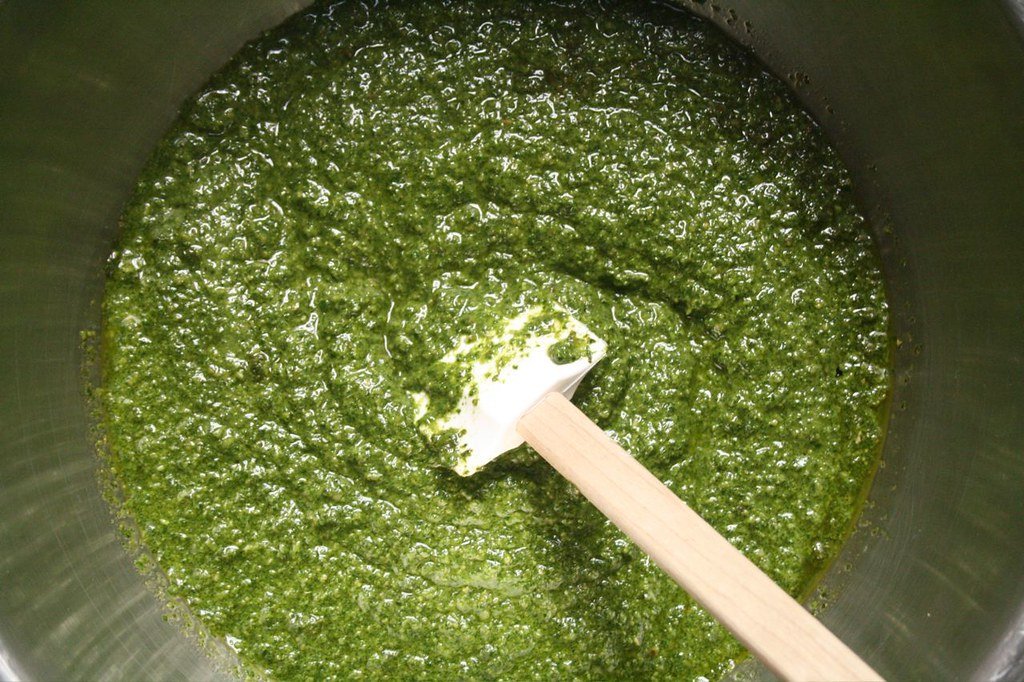Couscous with pesto combines quick cooking and vibrant flavors, making it a perfect dish for any meal. To whip up this delicious recipe, you’ll need couscous, boiling water, pesto, lemon juice, extra virgin olive oil, and a pinch of salt and pepper. The combination of fluffy couscous and rich pesto creates a delightful dish that satisfies your cravings and impresses your guests.
Couscous is very versatile; it pairs wonderfully with the fresh herb flavors of pesto. Whether you choose jarred pesto for convenience or make your own from scratch, this dish is easy to prepare and full of taste. It’s the kind of meal I find myself reaching for again and again, especially when I want something delicious without spending too much time in the kitchen.
What Is Couscous: Origins and History
Couscous is a type of food made from tiny granules of durum wheat. It originally hails from North Africa, particularly Morocco, where it serves as a staple dish.
The preparation of couscous dates back centuries. Many historians believe it originated among the Berber tribes. They crafted couscous as a versatile accompaniment to various meals.
Traditionally, cooks steam the couscous over a pot of stew. This method infuses the grains with rich flavors while keeping them light and fluffy.
Couscous gained popularity beyond North Africa in the 20th century. As travel and culinary exchanges increased, people worldwide discovered this delightful grain.
Today, I enjoy couscous in a variety of dishes. From salads to side dishes, it complements an array of flavors. Its adaptability makes it a favorite in my kitchen.
In different regions, I’ve encountered unique variations. For instance, Middle Eastern cuisine often flavors couscous with spices and scents of saffron or cinnamon. In contrast, Mediterranean recipes might focus on fresh herbs and vegetables.
Ingredients:
- 1 cup of couscous
- 1 cup of boiling water
- ¼ cup of pesto (homemade or jarred)
- ½ lemon, juiced
- 1 tbsp of extra virgin olive oil
- Salt and black pepper to taste
How to Make Couscous with Pesto?
- Combine the pesto and the couscous in a bowl.
- Add boiling water and stir briefly.
- Cover the bowl and let it sit for 5 minutes.
- Fluff the couscous with a fork.
- Add a splash of lemon juice, a drizzle of olive oil, and salt and pepper to taste.
- Stir and serve.
Serving Suggestions
Appropriate Accompaniments
For the perfect pairing, I often add grilled vegetables like zucchini, bell peppers, and eggplant. Their smoky flavor complements the freshness of the pesto.
I also consider proteins, such as grilled chicken or chickpeas, which provide texture and substance. If I want to keep it vegetarian, roasted chickpeas add a delightful crunch.
Additionally, a sprinkle of feta cheese or Parmesan can enrich the dish, adding a salty note. Fresh herbs like basil or parsley finish the plate beautifully and impart a burst of color.
Plating Techniques
I find that the way I plate this couscous dish significantly affects its appeal. I start by creating a bed of couscous on the plate, forming a small mound in the center. This highlights the dish and makes it inviting.
Next, I drizzle pesto artfully over the couscous, allowing it to pool slightly around the base. This creates a visually striking effect.
Storage and Reheating Tips
Refrigeration
- Cool it down: Let the couscous reach room temperature before storing.
- Store: Place it in the refrigerator. It’s best consumed within 3-5 days.
Freezing
- Portion it out: Use freezer-safe bags or containers.
- Label: Add the date and contents for easy identification.
Reheating
- Thaw: If frozen, I let it thaw in the fridge overnight.
- Microwave: I heat it in short intervals, stirring in between, until warm.
- Stovetop: For a stovetop method, I add a splash of water and stir over medium heat.
Adding extra pesto or a drizzle of olive oil brightens the flavors during reheating.
Common Mistakes to Avoid
- Using Too Much Water: Couscous absorbs water quickly. If you add too much, it will become mushy. Use a 1:1 ratio of water to couscous for the best texture.
- Overcooking the Couscous: To maintain a fluffy texture, let it steam for about 5 minutes. Don’t leave it on the heat for too long.
- Skipping Seasoning: Couscous needs flavor. Don’t skip seasoning the water with salt or adding herbs to enhance its taste.
- Ignoring Freshness: Using stale or store-bought pesto can dull the dish. I recommend using fresh pesto for vibrant flavors.
- Overloading with Ingredients: While tossing in many additions is tempting, keep it simple. Focus on the balance of flavors rather than overwhelming the dish.
Conclusion
Couscous with pesto offers a delightful blend of flavors. The nutty texture of couscous beautifully complements the rich, herby taste of pesto.
I enjoy preparing this dish for gatherings or a cozy night in. It’s versatile, allowing me to add vegetables, proteins, or cheese based on my mood.
This dish is not just quick to make, but it also satisfies different palates. It serves as a fantastic side or a light main course, making it my go-to.
I encourage you to experiment with different pesto, too. Each variation brings its unique twist to the dish.
Couscous with pesto truly delights every time I serve it. I hope you enjoy making it as much as I do!
Just so you know, this couscous dish can be a perfect accompaniment for a potato moussaka with eggplant!
Get the recipe now (by clicking the image below):






